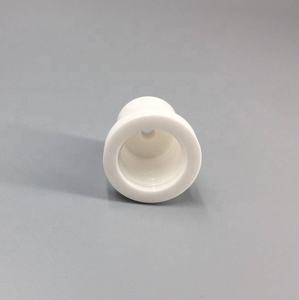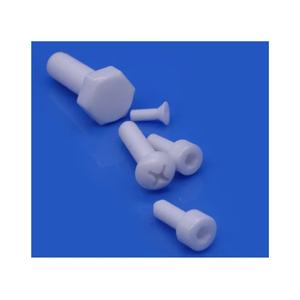1. Material Basics and Microstructural Layout
1.1 Composition and Crystallographic Security of Alumina
(Alumina Ceramic Nozzles)
Alumina (Al Two O TWO), especially in its alpha phase, is a totally oxidized ceramic with a corundum-type hexagonal close-packed framework, offering remarkable thermal stability, chemical inertness, and mechanical stamina at elevated temperature levels.
High-purity alumina (commonly 95– 99.9% Al Two O SIX) is chosen for nozzle applications because of its minimal pollutant content, which decreases grain border weakening and boosts resistance to thermal and chemical degradation.
The microstructure, containing fine, equiaxed grains, is engineered during sintering to lessen porosity and optimize thickness, straight influencing the nozzle’s disintegration resistance and architectural integrity under high-velocity liquid circulation.
Ingredients such as MgO are usually presented in trace amounts to prevent irregular grain development during sintering, making certain an uniform microstructure that supports long-lasting integrity.
1.2 Mechanical and Thermal Qualities Relevant to Nozzle Performance
Alumina porcelains exhibit a Vickers hardness exceeding 1800 HV, making them extremely resistant to rough wear from particulate-laden fluids, an essential attribute in applications such as sandblasting and unpleasant waterjet cutting.
With a flexural strength of 300– 500 MPa and a compressive strength over 2 GPa, alumina nozzles keep dimensional stability under high-pressure procedure, commonly varying from 100 to 400 MPa in commercial systems.
Thermally, alumina keeps its mechanical homes up to 1600 ° C, with a reduced thermal growth coefficient (~ 8 × 10 ⁻⁶/ K) that supplies outstanding resistance to thermal shock– essential when revealed to rapid temperature level changes throughout start-up or closure cycles.
Its thermal conductivity (~ 30 W/m · K) is sufficient to dissipate localized warm without causing thermal slopes that might result in fracturing, stabilizing insulation and warm monitoring demands.
2. Production Processes and Geometric Precision
2.1 Shaping and Sintering Methods for Nozzle Fabrication
The production of alumina ceramic nozzles starts with high-purity alumina powder, which is refined into an environment-friendly body using techniques such as cold isostatic pushing (CIP), shot molding, or extrusion, relying on the wanted geometry and batch size.
( Alumina Ceramic Nozzles)
Cold isostatic pressing uses consistent pressure from all directions, generating a homogeneous thickness distribution important for reducing issues during sintering.
Injection molding is utilized for intricate nozzle shapes with inner tapers and fine orifices, permitting high dimensional precision and reproducibility in automation.
After forming, the eco-friendly compacts undertake a two-stage thermal treatment: debinding to remove organic binders and sintering at temperature levels in between 1500 ° C and 1650 ° C to attain near-theoretical thickness through solid-state diffusion.
Precise control of sintering environment and heating/cooling prices is essential to protect against bending, fracturing, or grain coarsening that could compromise nozzle efficiency.
2.2 Machining, Polishing, and Quality Assurance
Post-sintering, alumina nozzles often call for precision machining to attain limited tolerances, especially in the orifice region where circulation characteristics are most conscious surface coating and geometry.
Diamond grinding and splashing are made use of to refine internal and exterior surface areas, achieving surface area roughness worths below 0.1 µm, which decreases flow resistance and prevents particle buildup.
The orifice, normally ranging from 0.3 to 3.0 mm in size, have to be devoid of micro-cracks and chamfers to ensure laminar circulation and regular spray patterns.
Non-destructive screening methods such as optical microscopy, X-ray inspection, and stress biking examinations are employed to verify structural honesty and efficiency uniformity prior to release.
Custom geometries, consisting of convergent-divergent (de Laval) profiles for supersonic flow or multi-hole varieties for follower spray patterns, are increasingly fabricated utilizing sophisticated tooling and computer-aided layout (CAD)-driven manufacturing.
3. Functional Benefits Over Alternate Nozzle Materials
3.1 Superior Erosion and Corrosion Resistance
Contrasted to metallic (e.g., tungsten carbide, stainless steel) or polymer nozzles, alumina exhibits much better resistance to abrasive wear, specifically in atmospheres entailing silica sand, garnet, or other tough abrasives made use of in surface preparation and cutting.
Metal nozzles weaken quickly due to micro-fracturing and plastic contortion, calling for regular substitute, whereas alumina nozzles can last 3– 5 times much longer, considerably reducing downtime and functional prices.
In addition, alumina is inert to most acids, alkalis, and solvents, making it suitable for chemical splashing, etching, and cleaning procedures where metal elements would certainly wear away or infect the liquid.
This chemical stability is specifically important in semiconductor manufacturing, pharmaceutical handling, and food-grade applications needing high purity.
3.2 Thermal and Electrical Insulation Feature
Alumina’s high electric resistivity (> 10 ¹⁴ Ω · cm) makes it optimal for usage in electrostatic spray finish systems, where it protects against charge leakage and ensures uniform paint atomization.
Its thermal insulation ability enables secure procedure in high-temperature spraying environments, such as fire spraying or thermal cleansing, without warm transfer to bordering parts.
Unlike metals, alumina does not catalyze undesirable chain reaction in responsive fluid streams, preserving the stability of delicate formulations.
4. Industrial Applications and Technological Impact
4.1 Roles in Abrasive Jet Machining and Surface Area Treatment
Alumina ceramic nozzles are crucial in unpleasant blasting systems for rust removal, paint stripping, and surface texturing in automotive, aerospace, and building and construction sectors.
Their ability to maintain a consistent orifice diameter over prolonged use ensures uniform unpleasant rate and effect angle, straight influencing surface area coating high quality and procedure repeatability.
In unpleasant waterjet cutting, alumina concentrating tubes assist the high-pressure water-abrasive combination, standing up to abrasive pressures that would quickly break down softer materials.
4.2 Use in Additive Manufacturing, Spray Covering, and Fluid Control
In thermal spray systems, such as plasma and flame spraying, alumina nozzles straight high-temperature gas circulations and molten particles onto substrates, gaining from their thermal shock resistance and dimensional security.
They are also used in precision spray nozzles for farming chemicals, inkjet systems, and fuel atomization, where wear resistance makes sure lasting application precision.
In 3D printing, specifically in binder jetting and material extrusion, alumina nozzles deliver fine powders or viscous pastes with minimal obstructing or use.
Emerging applications consist of microfluidic systems and lab-on-a-chip tools, where miniaturized alumina parts offer longevity and biocompatibility.
In summary, alumina ceramic nozzles represent a critical junction of products scientific research and industrial design.
Their extraordinary mix of solidity, thermal stability, and chemical resistance allows trusted efficiency in a few of the most requiring fluid handling settings.
As industrial procedures press toward greater pressures, finer resistances, and much longer service intervals, alumina porcelains remain to establish the requirement for resilient, high-precision circulation control elements.
5. Distributor
Alumina Technology Co., Ltd focus on the research and development, production and sales of aluminum oxide powder, aluminum oxide products, aluminum oxide crucible, etc., serving the electronics, ceramics, chemical and other industries. Since its establishment in 2005, the company has been committed to providing customers with the best products and services. If you are looking for high quality hydrated alumina, please feel free to contact us. (nanotrun@yahoo.com)
Tags: Alumina Ceramic Nozzles, Ceramic Nozzles, Alumina Nozzles
All articles and pictures are from the Internet. If there are any copyright issues, please contact us in time to delete.
Inquiry us

